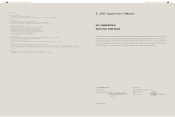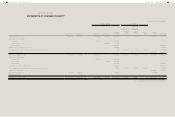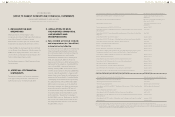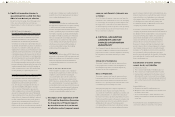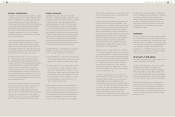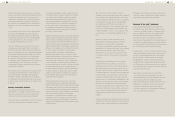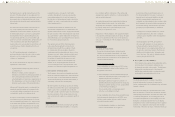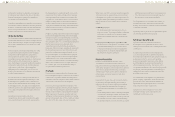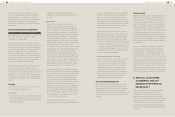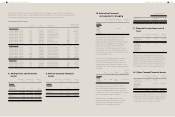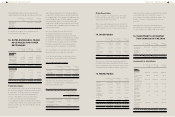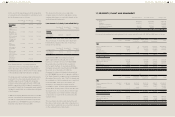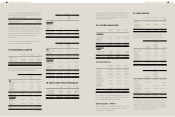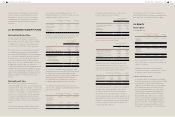HTC 2013 Annual Report Download - page 97
Download and view the complete annual report
Please find page 97 of the 2013 HTC annual report below. You can navigate through the pages in the report by either clicking on the pages listed below, or by using the keyword search tool below to find specific information within the annual report.
FINANCIAL INFORMATION FINANCIAL INFORMATION
190 191
If the recoverable amount of an asset (or cash-
generating unit) is estimated to be less than its
carrying amount, the carrying amount of the asset
(or cash-generating unit) is reduced to its recoverable
amount.
When an impairment loss subsequently is reversed, the
carrying amount of the asset or a cash-generating unit
is increased to the revised estimate of its recoverable
amount, but so that the increased carrying amount
does not exceed the carrying amount that would
have been determined had no impairment loss been
recognized for the asset (or cash-generating unit)
in prior years. A reversal of an impairment loss is
recognized immediately in profit or loss.
Financial Instruments
Financial assets and financial liabilities are recognized
when a group entity becomes a party to the
contractual provisions of the instruments.
Financial assets and financial liabilities are initially
measured at fair value. Transaction costs that are
directly attributable to the acquisition or issue of
financial assets and financial liabilities (other than
financial assets and financial liabilities at fair value
through profit or loss) are added to or deducted
from the fair value of the financial assets or financial
liabilities, as appropriate, on initial recognition.
Transaction costs directly attributable to the acquisition
of financial assets or financial liabilities at fair value
through profit or loss are recognized immediately in
profit or loss.
Financial assets
All regular way purchases or sales of financial assets
are recognized and derecognized on a trade date
basis/settlement date basis. Regular way purchases
or sales are purchases or sales of financial assets
that require delivery of assets within the time frame
established by regulation or convention in the
marketplace.
Derecognition of intangible assets
An intangible asset is derecognized on disposal, or
when no future economic benefits are expected
from use or disposal. Gains or losses arising from
derecognition of an intangible asset, measured as the
difference between the net disposal proceeds and the
carrying amount of the asset, are recognized in profit
or loss when the asset is derecognized.
Impairment of Tangible and Intangible
Assets Other Than Goodwill
At the end of each reporting period, the Company
reviews the carrying amounts of its tangible and
intangible assets, excluding goodwill, to determine
whether there is any indication that those assets
have suffered an impairment loss. If any such
indication exists, the recoverable amount of the asset
is estimated in order to determine the extent of the
impairment loss, if any. When it is not possible to
estimate the recoverable amount of an individual asset,
the Company estimates the recoverable amount of
the cash-generating unit to which the asset belongs.
When a reasonable and consistent basis of allocation
can be identified, corporate assets are also allocated
to individual cash-generating units, or otherwise they
are allocated to the smallest group of cash-generating
units for which a reasonable and consistent allocation
basis can be identified.
Intangible assets with indefinite useful lives and
intangible assets not yet available for use are tested for
impairment at least annually, and whenever there is an
indication that the asset may be impaired.
Recoverable amount is the higher of fair value less
costs to sell and value in use. In assessing value in use,
the estimated future cash flows are discounted to their
present value using a pre-tax discount rate that reflects
current market assessments of the time value of
money and the risks specific to the asset for which the
estimates of future cash flows have not been adjusted.
An item of property, plant and equipment is
derecognized upon disposal or when no future
economic benefits are expected to arise from the
continued use of the asset. Any gain or loss arising
on the disposal or retirement of an item of property,
plant and equipment is determined as the difference
between the sales proceeds and the carrying amount
of the asset and is recognized in profit or loss.
Goodwill
Goodwill arising on an acquisition of a business is
carried at cost as established at the date of acquisition
of the business less accumulated impairment losses, if
any.
For the purposes of impairment testing, goodwill is
allocated to each of the Company's cash-generating
units (or groups of cash-generating units).
A cash-generating unit to which goodwill has been
allocated is tested for impairment annually, or more
frequently when there is an indication that the unit
may be impaired, by comparing its carrying amount,
including the allocated goodwill, with its recoverable
amount. However, if the goodwill allocated to a cash-
generating unit was acquired during the current annual
period, that unit shall be tested for impairment before
the end of the current annual period. If the recoverable
amount of the cash-generating unit is less than its
carrying amount, the impairment loss is allocated
first to reduce the carrying amount of any goodwill
allocated to the unit and then to the other assets of
the unit pro rata based on the carrying amount of each
asset in the unit. Any impairment loss is recognized
directly in profit or loss. An impairment loss
recognized on goodwill is not reversed in subsequent
periods.
If goodwill has been allocated to a cash-generating
unit and the Company disposes of an operation within
that unit, the goodwill associated with the operation
disposed of is included in the carrying amount of
the operation when determining the gain or loss on
disposal.
When investment in subsidiary accounted for by equity
method is tested for impairment, the cash-generating
unit is determined based on the financial statements
as a whole. If the recoverable amount of the asset
subsequently increases, the reversal of the impairment
loss is recognized as a gain, but the increased carrying
amount of an asset after a reversal of an impairment
loss shall not exceed the carrying amount that
would have been determined (net of amortization or
depreciation) had no impairment loss been recognized
on the asset in prior years.
Intangible Assets
Intangible assets acquired separately
Intangible assets with finite useful lives that are
acquired separately are initially measured at cost and
subsequently measured at cost less accumulated
amortization and accumulated impairment loss.
Amortization is recognized on a straight-line basis over
their estimated useful lives. The estimated useful life,
residual value, and amortization method are reviewed
at the end of each reporting period, with the effect
of any changes in estimate being accounted for on a
prospective basis which is in accordance with IAS 8
"Accounting Policies, Changes in Accounting Estimates
and Errors". The residual value of an intangible
asset with a finite useful life shall be assumed to
be zero unless the Company expects to dispose of
the intangible asset before the end of its economic
life. Intangible assets with indefinite useful lives
that are acquired separately are carried at cost less
accumulated impairment losses.
Intangible assets acquired in a business combination
Intangible assets acquired in a business combination
and recognized separately from goodwill are initially
recognized at their fair value at the acquisition date
(which is regarded as their cost). Subsequent to initial
recognition, intangible assets acquired in a business
combination are reported at cost less accumulated
amortization and accumulated impairment losses, on
the same basis as intangible assets that are acquired
separately.


